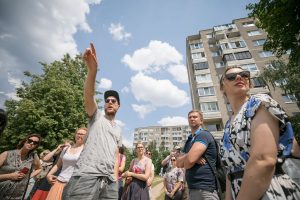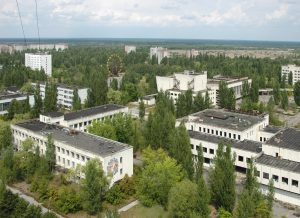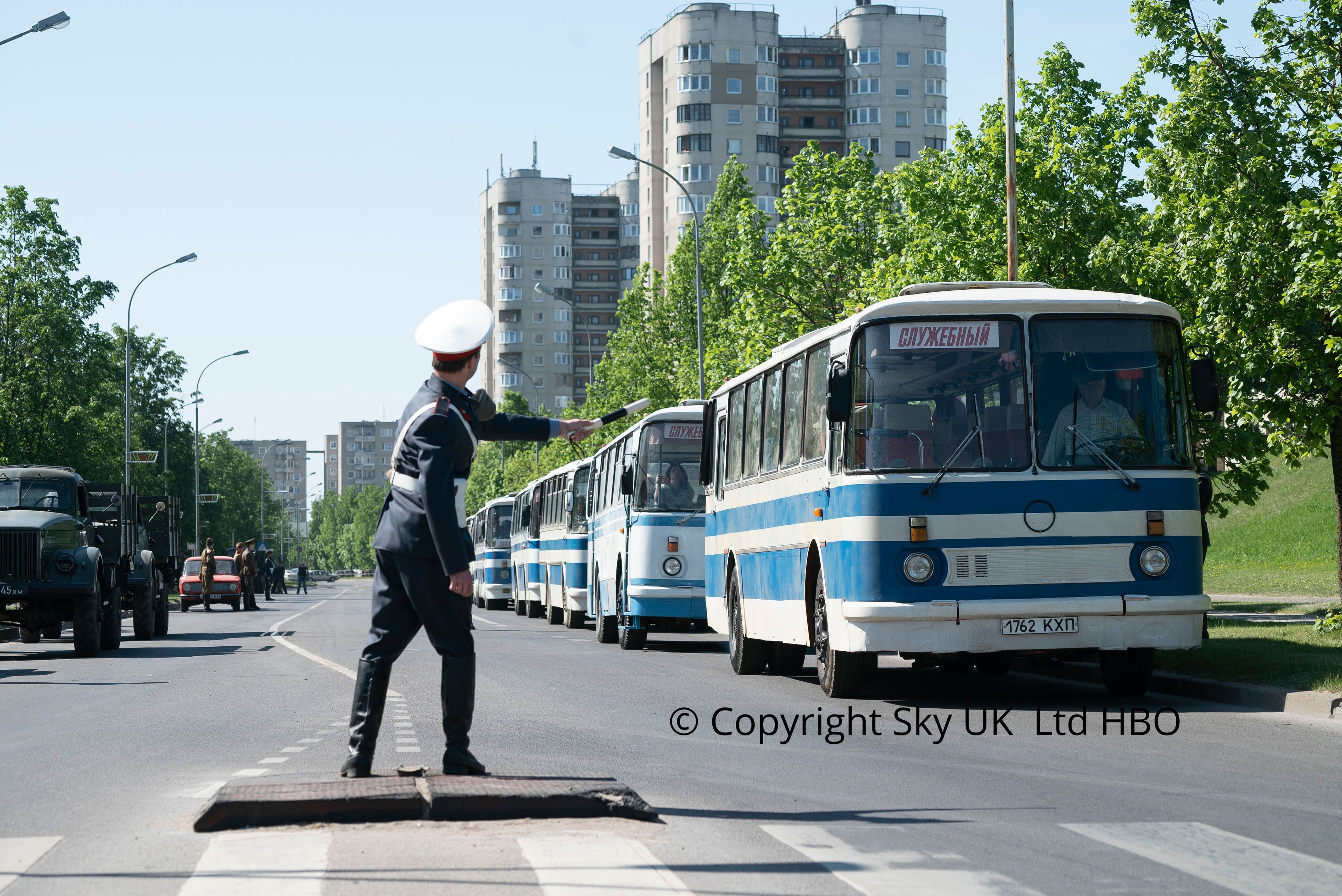Linas Jegelevičius.
Fabijoniškės, a dreary residential district in the northern part of Vilnius, has recently become a major tourist draw. The Soviet-style high-rise apartment complex built in the late 1980s served as the production site for the television event of the year, the HBO miniseries “Chernobyl,” that dramatized the 1986 nuclear disaster in Ukraine. Fabijoniškės was chosen as the doppelgänger of Pripyat, a city established to house the workers of the nearby Chernobyl plant. Pripyat was where most of the human drama took place in the series, and now, of course, it’s an uninhabitable ghost town.
After the series hit TV screens around the globe, tourists have descended onto Vilnius, eager to hear stories about Lithuania’s Soviet past and to visit the sites filmed.

The chairman of the Fabijoniškės Community Association Alvaras Bacevičius was thrilled to see Fabijoniškės depicted in the series. “We could not have devised a better PR campaign for our district. It was a once-in-a-lifetime opportunity, and I am happy it happened to us,” he said.
He added, that before filming began, the production company spruced up the area and fixed up some buildings, making them look like the edifices of Pripyat. As a result, the full-time residents had to endure some inconveniences, like parking and traffic restrictions, but, according to Bacevičius, that perturbed only the most cantankerous of inhabitants.
He also said that some lamented having their neighborhood compared to a typical Soviet residential district from the mid-1980s. According to them, that’s nothing to boast about. But Bacevičius countered that the newly built power plant towns were showpieces. “Pripyat, like our Visaginas, was the best maintained, most orderly and advanced town of the time.” (Visaginas, located in northeast Lithuania, was established in the 1990s as a residential area for workers constructing the Ignalina nuclear power plant.)
Bacevičius continued that the benefits for Vilnius rising from the hoopla produced by the miniseries are tangible.
“I am not just talking about the buzz created by the international tourist attention to our district. (I heard that there are guide-led tours of Fabijoniškės, although I have not encountered any of them yet.) I appreciate that our neighborhood has grown closer as a result of the filming. Being perceived as important to the rest of the world has helped develop a strong sense of community. The excitement hasn’t fizzled out yet. Whenever our residents meet, they immediately strike up conversations about the movie,” Bacevičius observed.
He enjoyed seeing on the screen that familiar stray dog roaming Stanevičius street and the greyish buildings and parking lots he passes by every day. “It’s was an awesome feeling. I wish I had the chance to see the entire miniseries,” Bacevičius said.
Tourist attractions?
With the word on “Chernobyl” hitting the headlines globally, at least four tour operators – Vilnius with Locals, Travel Addict, Vilnius Urban Adventures and feelZcity – as well as some independents, are now offering guided excursions to the much-publicized Fabijoniškės district of Vilnius.
Jelena Avinienė, a project manager at feelZcity, said that they conduct tours Wednesday through Sunday, which last about two and a half hours. They cost 39 euros per person. The visitors are mostly Americans, Brits, Scandinavians, and Europeans.

According to Avinienė, tourists are not only interested in the Chernobyl catastrophe and what is authentic and what is contrived in the film, but they are also eager to learn about the Soviet era – how people lived back then. “They want confirmation that the scenes in the miniseries accurately depict Soviet life. Some larger private groups ask to ride in a Soviet bus that was used in the series. Others want to try Soviet food or visit the now-defunct Ignalina power plant.”
FeelZcity also takes tourists to the Lithuanian Interior Ministry Culture Palace, located in Žirmūnai, where parts of the miniseries were shot.
“Many have questions about the Soviet apartment blocks, specifically if it’s safe to live there. Interestingly, we have quite a few visitors who have not seen the series yet, but are curious about Soviet life in general,” Avinienė said. Tour participants also ask to visit the KGB museum, where Lithuanians were tortured and jailed during the Stalin years.
Joana Mikulska, head of the Vilnius Tourism Information Center, said that following the release of the film, phones at the center were ringing off the hook. “Most of the interested callers are British, inquiring about the movie and where it was shot. In response, we published a booklet about ‘Chernobyl’ and its filming locations. We also promote the movie to local tourism-based businesses, which, we believe, can benefit from the attention.”

Mikulska added that “Chernobyl” was not the first TV series filmed in Vilnius. Recently, the Lithuanian capital entertained crews filming Netflix’s the “Last Tsars” series, BBC’s “War and Peace,” and HBO’s and Sky’s “Catherine the Great.”
Baltic Film Services founder Lineta Mišeikytė confirmed that many foreign producers hold a positive view of working in Vilnius. “They appreciate its compactness and accessibility, and they praise our skilled talent pool. When filming ‘Chernobyl,’ the Vilnius municipality readily accommodated the producers’ requests. For example, it converted certain areas in Fabijoniškės to look more like authentic Ukrainian Pripyat.”
Furthermore, a tax exemption was granted to the “Chernobyl” project. Lithuanian legislation now allows local companies to reduce their profit tax provided they allocate funds for film production. In 2014-2018, such a tax privilege was given to some 115 films. As a result, upwards to 17 million euros have been invested under this tax program.
Local talent recognized
For Povilas Jatkevičius, an aspiring yet still little known Lithuanian actor, “Chernobyl” may provide a springboard to the big screen. I reached him by phone in London, where he was going through multiple casting calls and acquainting himself with the British film industry.
“I was not even born when the calamity struck, but I heard quite a bit about it from my parents. I was over the moon when I got a part. Wow!” Jatkevičius played a firefighter called Kibinok in “Chernobyl.” I asked him why he thought he was cast, and he chuckled, saying, “I reckon I was chosen for my vintage appearance. The casting director told me that under no circumstance was I to cut my long hair,” he said.
Jatkevičius said that even if his trip to London does not land him a Hollywood contract, he’ll be okay; he has already secured a role with the National Drama Theater in Kaunas.
“Chernobyl” brings back memories
Notwithstanding the positive effects “Chernobyl,” the miniseries, had on Vilnius, for many older Lithuanians, who lived through the nuclear meltdown scare, the public fascination with the bygone Soviet era is disconcerting. It is especially true for those who served in the Soviet Army at the time of the accident. Some were assigned to clean-up work – to extinguish the radioactive blaze or help erect the sarcophagus to contain the smoldering plant. For these Chernobyl disaster survivors, the movie opened up old wounds that never had a chance to heal fully.
“I did not see the film, and I am not sure I want to see it. This fictionalized account of history has revived the past. It is difficult to distance myself from it and remain calm,” Artūras Mažrimas, a resident of Klaipėda, said.
In 1986, at the age of 20, Mažrimas was serving in the Soviet army. He was stationed at a military base a mere 100 kilometers from the Chernobyl plant when it blew up.

“We arrived at this unbelievable disaster site just three hours after the explosion. No one told us what happened. Three days later and only after the foreign radio stations broke the story did the authorities confirm that a nuclear accident took place. They assured us that it did not pose much of a health risk,” Mažrimas recounted. The young soldiers, who were serving from all parts of the Soviet Union, were offered no iodine or protective clothing.
“Like the other soldiers, I was advised to drink milk, which was available in abundance in the canteen at the plant. Only later, my concerned parents began sending me vitamins. One month after our deployment to the plant, many of my army buddies began to complain that they would never “need women in their lives” – they had become impotent. It is only by the grace of God that I fathered three children, retained my sanity, and am still in pretty good health at 52 years of age. I have heard that only about a dozen of the 110 men from my company are still alive today,” Mažrimas said.
Pranas Paškevičius, head of the Lithuanian Chernobyl Movement, refrained from discussing the film.
“I refused to speak to Reuters and the Associated Press. How can I comment on it, when it’s all fabricated, fanciful? The Chernobyl clean-up workers, the local people, the liquidators, scientists, and functionaries are all imagined,” he said. “I also feel disheartened that Fabijoniškės is shown as a Soviet residential district from the past,” he added.
The Chernobyl Movement has 17 chapters throughout Lithuania, but Paškevičius could not say how many survivors presently belong to the organization. “As time goes on, fewer of us remain alive. Besides, we do not have the financial resources to organize conferences for members to meet and recall what happened to us in 1986,” Paškevičius said.
According to him, Lithuania lags behind Latvia in awarding compensations to Chernobyl survivors. “They have separate regulations regarding Chernobyl clean-up participants. Latvia is praised internationally for taking care of them,” he said.
It is believed that about 10,000 Lithuanians participated in the Chernobyl clean-up operations.
More information on the Chernobyl tours in Vilnius can be found on http://www.vilnius-events.lt/en/ and www.feelzcity.com.

 DRAUGAS NEWS Lithuanian World Wide News in English
DRAUGAS NEWS Lithuanian World Wide News in English
